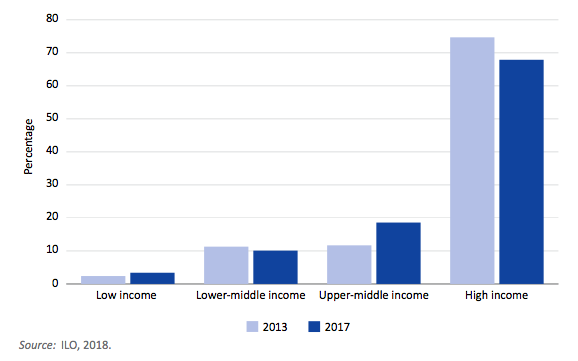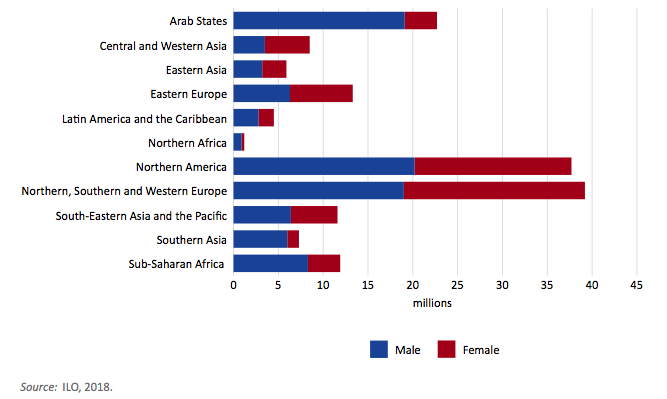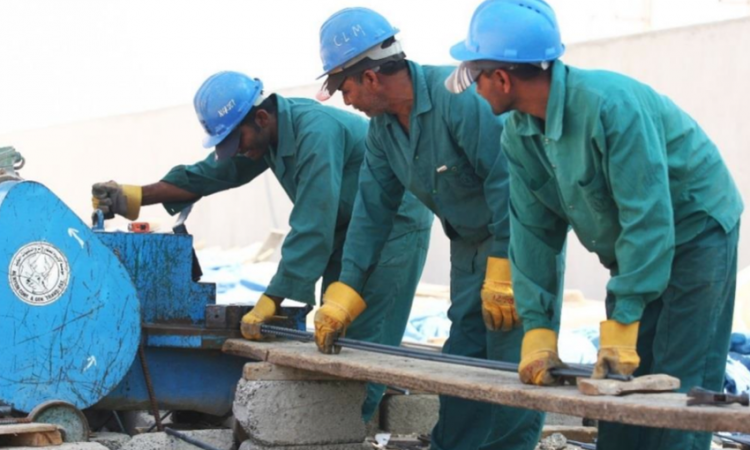The latest available estimates indicate that there were roughly 164 million migrant workers around the world in 2017, accounting for nearly two thirds (64%) of the (then) 258 million global stock of international migrants. When compared with the global population of international migrants of working age – regarded as 15 years of age or older (234 million) – migrant workers account for 70%. For a range of reasons, however, these global figures are likely to be underestimates. While earlier global estimates of migrant workers have been produced, ILO notes that these cannot be compared with 2017 figures, due to definitional differences and changes in methodology and data sources.
In 2017, 68 per cent of migrant workers were residing in high-income level countries – an estimated 111 million people. An additional 47 million migrant workers (29%) were living in middle-income countries, and 5.6 million (3.4%) were in low-income countries. While we are unable to compare the numbers of migrant workers over time, it is useful to examine changes in proportional distribution. In 2017, for example, there was a noticeable change in destination country category; that is, from 2013 to 2017, high-income countries experienced a 7 percentage point drop in migrant workers (from 75% to 68%), while upper-middle-income countries observed a 7 percentage point increase (from 12% to 19%). This apparent shift may be influenced by economic growth in middle-income countries and / or changes to labour immigration regulations in high-income countries. The share of migrant workers in the total workforce across country income groups was quite small in low-income (1.9%), lower-income (1.4%) and upper-middle-income countries (2.2%), but much greater for high-income countries (18.5%).
Migrant workers by destination country income level, 2013 and 2017

Male migrant workers outnumbered female migrant workers by 28 million in 2017, with 96 million males (58%) and 68 million females (42%), in a context where males comprised a higher number of international migrants of working age (127 million or 54%, compared with 107 million or 46% females). This represents a slight shift since 2013, towards an even more gendered migrant worker population, when the share of male migrant workers constituted 56% and females 44%.
Migrant workers, by sex and income level of destination countries, 2017

As evident from the data, the international migrant worker population is currently gendered as well as geographically concentrated. There is a much larger number of male than female migrant workers worldwide, with a gender composition that sees much higher numbers of men in low-income and lower- middle income countries compared with women, and in contrast to the gender splits for high-income countries. In terms of geography, and as seen in figure below, 99.6 million or almost 61 per cent of all migrant workers resided in three subregions: Northern America; the Arab States; and Northern, Southern and Western Europe. Notably, there is a striking gender imbalance of migrant workers in two regions: Southern Asia (6 million males compared with 1.3 million females) and the Arab States (19.1 million males compared with 3.6 million females). The Arab States region is one of the top destinations for migrant workers, where they can dominate key sectors. For example, in the Gulf States, over 95% of the labour force for construction and domestic work is comprised of migrant workers. From 2013 to 2017, the number of migrant workers in the Arab States increased by over 5%, following greater demand for male migrant workers, many of whom are involved in manual labour, mostly in the construction sector.
Geographic distribution of migrant workers by sex, 2017

SOURCES: IOM, OECD, ILO
IMAGE CREDIT: United Nations

